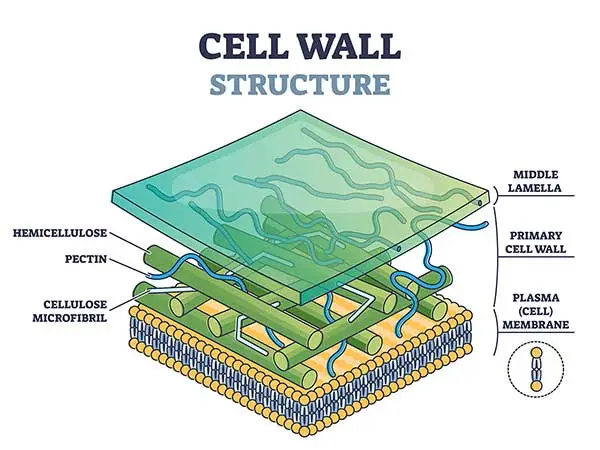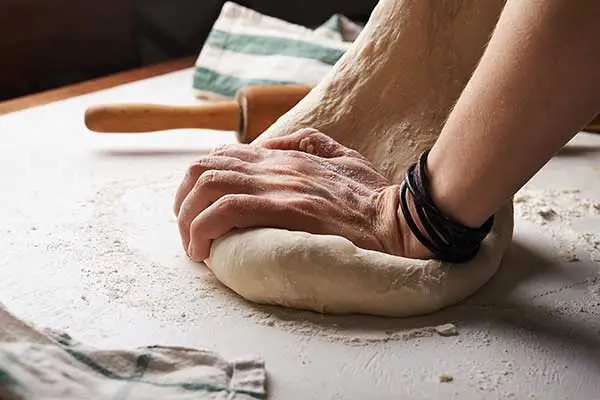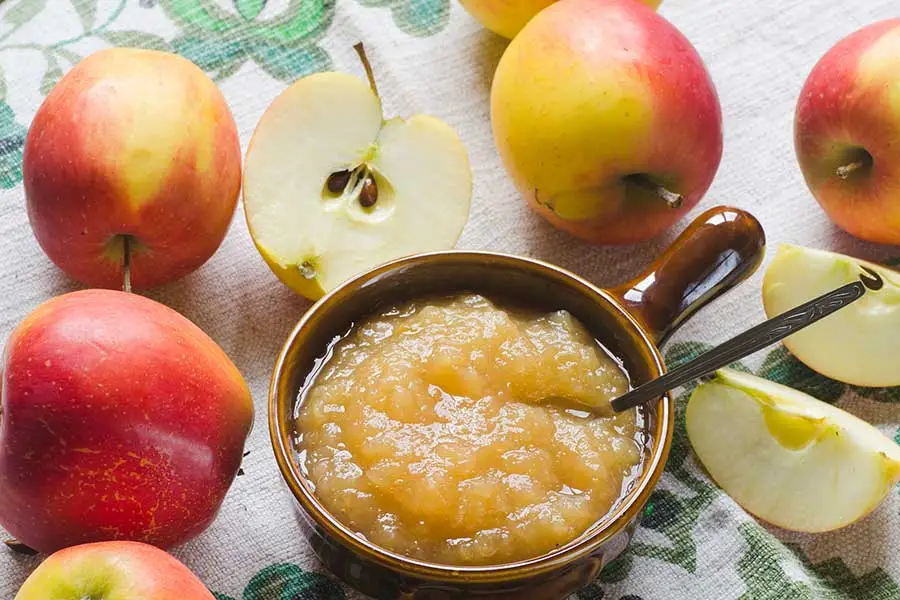Author: Tosh Lubek Published: 20th January 2022
KitchenAcorns.com is supported by its readers. Please assume links on this site are affiliate links or ads, and that I get commissions for purchases made through these links. As an Amazon Associate, I earn from qualifying purchases. Thank you if you use any of the links.
If you enjoy baking, you’ll know that butter, fats, oil, and eggs will regularly feature in your recipes. But all these ingredients are a source of extra calories when you make your favorite cakes, muffins, and waffles. So, is there an alternative to these ingredients? Fortunately, you can make your baking low-fat and even free of animal fats.
Applesauce or pureed bananas can be used in baking instead of butter, fats, oils, and eggs. The pectin in the fruit reduces the growth of long strands of gluten that would otherwise make your baked goods chewy instead of light, airy, and fluffy.
How Fats, Oil, and Eggs Work in Baking
To understand how this works, you first need to know why fats or oils are used in baking.
Two of the main ingredients in baking are flour and water, although the water might be in milk or eggs. When flour and water are mixed, two proteins in the flour, gliadin, and glutenin, are activated. The water allows these proteins to unravel and combine, to form long strands of gluten. The more you mix these ingredients you form more of these long stretchy strands of gluten.
Now gluten isn’t necessarily a bad thing, especially if you are making bread dough. Kneading the dough for several minutes creates lots of these stretchy gluten strands that provide the internal structure for the bread, allowing it to rise and make it chewy.
When baking bread, making lots of gluten is desirable, but less so with other types of baking. For instance, cakes, muffins, and waffles don’t need too much gluten because they are not meant to be chewy. In fact, they should have a texture that is light, airy, and fluffy.
So, how do you stop the formation of too much gluten when you mix flour and water?
Normally we use fat or oil in the batter.
As you probably know, oil and water usually don’t mix. Oils and fats are hydrophobic, meaning they repel water. It’s this property that we use to try and keep the flour and water apart. The oil coats the protein molecules in the flour, creating a barrier so the water cannot activate the proteins, in this manner reducing the amount of those gluten strands that are produced.
Basically, we want to use another ingredient that, like fats and oils, will inhibit the formation of those long stretchy gluten strands.
One option is to use pectin.
What is Pectin and why is it used in cooking?
Pectin is found in nearly all fruits and vegetables, where it is concentrated in the plant cell walls. It’s effectively the glue that holds the plant cells together, providing the structural strength in the fruit or vegetable.
The primary cell walls of plants are made of various substances, including cellulose microfibrils and hemicellulose. The hemicellulose binds to the surface of the cellulose microfibrils and pectin combines with water molecules to form a gel between the cellulose-hemicellulose network, holding it in place. You can see the structure in the diagram below, where the pectin is shown as blue strands.

You’ll use pectin in your kitchen if you’re a jam maker. It is a natural substance that is used to set jams, jellies, and marmalades.
Pectin is used in cooking by mixing with water, a little acid, and sugar. The pectin forms a jelly-like mesh that traps water producing gelling or thickening. In preserve or jam making it is this gelling process that sets the preserve or jam as it cools.
Using the Pectin in Applesauce to replace Fats and Oils in Baking
As noted above, most fruits and vegetables contain pectin. One fruit that is commonly used in kitchens is the apple, which contains a good amount of pectin, especially when just ripe. Since we need to blend the apple with the other recipe ingredients the apple would need to be mashed or puréed. However, a more convenient option is to cheat and use readymade applesauce.
Applesauce can be substituted for fats, oils, and eggs in baking recipes because it too reduces the interaction between water and the proteins in the flour. Although it does it in a different way. The pectin in applesauce reduces the production of those stretchy gluten strands by holding on to the water in the cake or batter mix, forming a kind of jelly-like structure. This reduces the amount of water that is available to activate the flour proteins, although, just like baking with fats and oils, you should avoid over-mixing the ingredients to minimize the formation of gluten.
Another cool feature of using the pectin in applesauce is that it also mimics how the protein in egg whites functions in a cake mix. The pectin, like the protein molecules in egg whites, provides some structure to the cake, muffin, or waffle, by forming an interconnected network when heated. The same reason pectin is used in jam, jelly, and preserve making, where it sets the boiled fruit juice or fruit.
Here’s a cool video from SciShow that clearly explains using Applesauce to replace fat, oil, and eggs in baking.
Can other ingredients also be used as a fat or oil replacement?

Applesauce isn’t the only ingredient you can use to replace fats and oils in your baking recipes. So, apples are not particularly special, other than they contain a moderate amount of pectin, usually about 1-1.5%.
All fruits and vegetables contain pectin to varying degrees and the amount of pectin changes over time. The amount usually reaches a maximum when the fruit is just about to ripen, after ripening the amount of pectin gradually declines.
The decline of pectin has a physical effect on the fruit. As an example, an apple shows this well. It is very firm before it is ripe enough for eating, but as it ripens the flesh softens a little, eventually becoming a bit mushy when it is overripe and starting to decay. Throughout that process, the pectin level declines, and with less pectin to provide the glue that holds the apple’s cell walls together, the flesh becomes softer and less crisp to the bite.
So, when baking and you want the maximum amount of pectin, don’t use very ripe fruit or vegetables.
However, the amount of pectin in the fruit also depends on the fruit or vegetable you choose. Those rich in pectin include Apples, Apricots, Bananas, Blackberries, Black Currants, Carrots, Citrus Fruits, Crab Apples, Cranberries, Elderberries, Gooseberries, Grapes, passionfruit, Plums, Red Currants, Quinces, Rosehips, and Sweet Potatoes.
Here are some typical pectin concentrations for fruits and vegetables with moderate to high pectin levels.
| Fruit/Vegetable | Pectin level |
|---|---|
| Apples | 1-1.5% |
| Apricots | 1% |
| Bananas | 0.5 to 1.28% |
| Carrots | 1.4% |
| Citrus peels | 30% |
| Oranges | 0.5–3.5% |
| Rosehips | 15% |
| Sweet Potato | 15–23% |
Although all the fruits and vegetables I’ve mentioned above contain high levels of pectin not all of them would necessarily be good to bake with. Unless you want a cake with the strong color or flavor of certain fruits or vegetables, you need to be careful in choosing the source of the pectin. So, if you are making a plain Victoria sponge you probably won’t want to use blackberries and Elderberries.
To replace fats and oils in your baking the best options are applesauce, mashed bananas, mashed sweet potato, or pureed apricots or passionfruit. These have the advantage over other fruits because their colors and flavors are less intense and less likely to affect the recipe.
Using Pectin Powder in Baking
You might be wondering that if it is the pectin in applesauce, mashed bananas, and pureed fruit that it important, then why not use straight pectin in your baking. Well, you can. Although going down the fruit route does add extra bulk and flavor.
There are several ways pectin can help in baking.
The use of pectin in making hams and jellies is well known. By heating a mix of pectin, sugar, and fruit acid you create a thick gel that will set as it cools down.
You can use liquid or powdered pectin to thicken fruit pie fillings. If you’re making open-top fruit pies or tarts less pectin is needed because some water will evaporate during baking.
Powder pectin will dissolve in cold water but be careful. It can form large lumps that you’ll find are difficult to get rid of because the pectin and water form a protective gel around the lump of pectin powder. When adding powdered pectin to water make sure you add the pectin gradually and continuously mix rapidly. A better way of adding pectin powder is to add it to other dry soluble ingredients, like sugar, and whisk this mixture into the wet ingredients.
However, pectin can be used in baking as an ingredient in doughs and batters and not just to gel fruit fillings. For instance, pectin can be used in bread making.

If you are making bread that requires higher levels of water, pectin can be added to the flour which will make the dough easier to work. And because pectin is good at forming water gels it helps the bread to stay moist for longer and produces a softer crumb. The addition of pectin can also enhance the rise of the dough and the volume of your baked bread. Pectin’s gelling properties combine with the stretchy gluten network to help create a structure better able to trap the carbon dioxide gas produced by your preferred raising agent, either yeast or baking soda, leading to more rise and a larger loaf.
To use pectin in your bread making add about 1/3 to ½ an ounce of pectin powder per pound of flour.
Pectin is widely used in commercial baked goods as a fat replacer without altering the texture or feel of the product in the mouth. In fact, because of pectin’s gelling properties, the baked goods can have a more tender texture. When using pectin in home baking start by reducing the amount of fat by up to a third. This should produce baked goods that are like the full-fat version while cutting the calories.
You might also like…
Need a new waffle maker? See the excellent choice on Amazon
Tosh learned how to cook while watching his Polish Mom at home. He also worked in a family-owned restaurant while a student and learned much from the chefs. Cooking has always interested him, especially the hearty Polish recipes he learned from his mother. He has helped create and appeared on cookery shows on radio stations in Scotland.
Recent Posts
This family pancake recipe will make about thirty-six pancakes that have a thickness of about 3/8th to half an inch and a diameter of about 4 inches. In my family, I would often prepare a batch of...
If you want to know a lot more about waffles but don’t have the time to read through loads of articles, you’re in the right place. I’ve collected together 25 of the most often asked...











